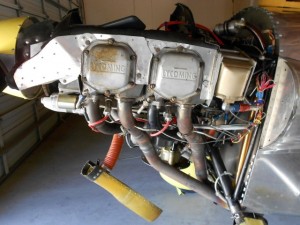ROT – Rule of Thumb.
In the world of experimental aviation, it seems that there are a never ending supply of people that believe that they can make an internal combustion engine produce a great deal of power while using a very little fuel. This is nothing new – it’s been going on for as long as I can remember and I’m sure a very long time prior to that.
The advertisements and/or discussions usually go something like this: “We are selling this new design, mega-techie, super duper engine that produces 100 horsepower (HP) and burns ONLY three gallons of fuel per hour (GPH).”
 Sounds wonderful doesn’t it? There is usually a bunch of sales speak about fuel injection, turbocharging, direct-injection, high-compression, variable camshaft timing, computer design manifolds, magnets on the fuel lines, etc…
Sounds wonderful doesn’t it? There is usually a bunch of sales speak about fuel injection, turbocharging, direct-injection, high-compression, variable camshaft timing, computer design manifolds, magnets on the fuel lines, etc…
Sadly, it isn’t true. Nonetheless, people believe it and buy in only to be disappointed.
Brake Specific Fuel Consumption (BFSC) is basically a measure of combustion efficiency – how efficiently a certain amount of fuel is being converted into a specific amount of power (horsepower). How and at what stage of operation this is measured is all fairly complex and I sure don’t claim to be an expert.
Here’s the deal. Mankind’s current level of knowledge in regard to the internal combustion engine/motor allows us to build general aviation engines that achieve a BSFC of about .5. Some engines a little better, some a little worse. Like in the marine environment, aviation engines produce relatively high levels of power continuously so measuring BFSC at low power settings is of no use. A very good rule of thumb that can be used for some basic fact checking is that engines will have a BFSC of about .5.
With the knowledge in hand, it is very easy for you to do a very simple fact check when this type of marketing is produced. Two approaches can be taken:
- Use the stated fuel flow and determine what the probable power output is. This is done by multiplying the gallons of fuel by six to get pounds of fuel consumed per hour and then dividing this by .5 (the BFSC). Using the 3 GPH claim from above, 3 x 6 = 18 pounds of fuel. 18/.5 = 36 horsepower. A long ways from 100 HP.
- Use the stated horsepower and determine what the likely fuel burn is. This is done by multiplying the horsepower claim by .5 (BFSC). Using the 100 HP claim from above, 100 x .5 = 50 pounds of fuel. 50 pounds divided by six gallons/pound = 8.3 GPH. A long ways from 3 GPH.
Pick a method and practice a couple times. Very quickly you will be able to do this fact check in your head and it may save you a lot of money and time someday. A lot of people have spent a great deal of money and time installing the latest, greatest whiz bang engine only to find that their airplane doesn’t have enough power to fly or isn’t performing like it should.
As I see it, if an individual or company is willing to lie (a little or a lot) about some things, they are willing to do it with everything. I want nothing to do with those individuals or companies.
Oh, please be aware that horsepower claims are nearly always at sea level. Another good rule of thumb is that any normally aspirated (non-turbo or super charged engine) will loose roughly 3% of it’s output per thousand feet of elevation gained. Thus, an engine that produces 100 HP at sea level will loose approximately 30% of it’s output at 10,000′ and so will be producing about 70 HP. Of course, this assumes that the correct fuel-to-air mixture is maintained.


Leave a Reply